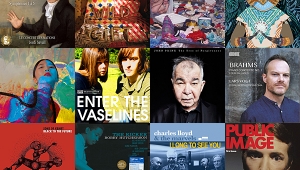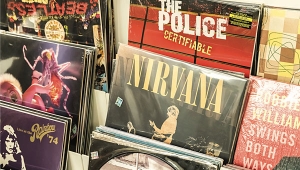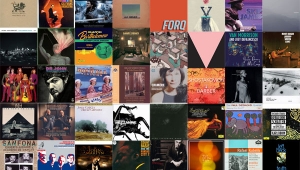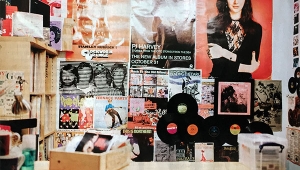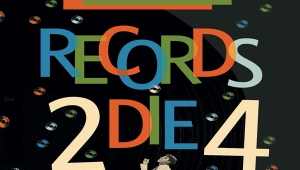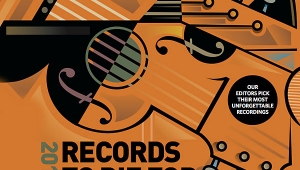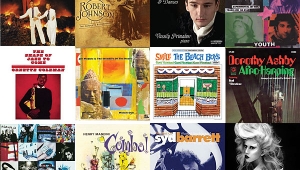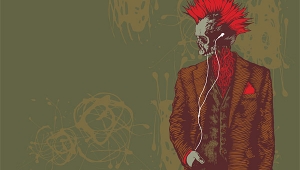| Columns Retired Columns & Blogs |
2003 Records To Die For Page 5
Fred Mills
FREE: Tons of Sobs
Island IMCD 281 (CD). 1968/2001. Guy Stevens, prod.; Andy Johns, eng. AAD? TT: 70:30
Everyone has an early musical mentor. Mine was Cotton, a high-school senior who fit the longhaired, pot-dealing, hippie-delinquent mold to a T. When he turned me on to Free's 1968 debut album, my teenage mind fissured, steamed, and gurgled like a flow of hot lava. From Paul Rodger's cock-rock vocal strut to Paul Kossoff's sensual guitar leads to the efficient bottom end of Andy Fraser and Simon Kirke, well, suffice it to say that, after Free's coming, the British blues boom of the '60s was reconfigured into something less studied and far more erotically charged. Free, of course, spawned Bad Company, of which the less said, the better. Cotton wound up on the wrong side of an LSD trip en route to a mental ward. But three decades on, the music of Free sounds just as liberating as ever. This remastered edition adds 33 minutes of BBC sessions, mono versions, and alternate takes.
U2: October
Island 4228 42297 (CD). 1981. Steve Lillywhite, prod., eng. AAD? TT: 41:09
Christian rock has gone overground in a big way of late; the genre even has its own garishly designed Heritage USA by way of arena kings Creed (whose Scott Stapp is its Tammy Faye Bakker). So it's easy to forget that, more than 20 years ago, an explicitly faith-based record appeared at the hands of a still-building Irish phenomenon known as U2. There's no mistaking the band's intent on this sonic cloak of many colors: present are classic images of earth, sky, fire, and water, chronicles of personal tribulations, the religious concept of "surrender," even a devotional tune sung partly in Latin ("Gloria"). But what elevates October above any standard-issue, namby-pamby Jesus rockin' is the music, equal parts psychedelic brawn, atmospheric elegance, and a hard-to-define charisma—the last of which, in conjunction with singer Bono's motormouth, would eventually drop-kick U2 into superstar territory even as the band steadily shed its Christian raiment.
BLUR: Parklife
SBK/ERG 8 29194 2 (CD). 1994. Stephen Hague, prod., eng.; Stephen Street, prod.; John Smith, eng. DDD. TT: 52:38
A Kinks for the 1990s, Blur delivered their masterwork of British working-class life with their third album, Parklife. Although still deeply influenced by the past—the band had previously adopted the scooter-and-parka look and sound of '60s Mods—Parklife is more modern and dizzily ambitious than their previous albums. It's full of lush orchestral pop and jagged power chords, in service to singer Damon Albarn's acerbic takes on everyday life in the 'hood (specifically, Fulham, London), with one sonic side trip ("Boys and Girls") to spy on English teenagers discovering all manner of sexual couplings while on holiday in the Mediterranean. The band still sounds at times like everyone from the Who to the Jam to XTC, but it never sacrifices its own identity on the altar of retro purity, creating in Parklife a classic album worthy of its first and second British Invasion heroes.
LINDA THOMPSON: Fashionably Late
Rounder 11661-3182-2 (CD). 2002. Edward Haber, prod., eng.; Linda Thompson, Teddy Thompson, John McCusker, prods.; Steve Deutsch, Joe Rusby, Eve Seltzer, John Wood, Steven Heller, Richard Barron, Rob Keyloch, Tom Leader, Mark Tucker, Alex Balzama, engs. DDD. TT: 40:10
Linda Thompson's return to music in 2002 was no mere "comeback"—it was a not-so-minor miracle. Thompson retired in 1985, the victim of a disorder that left one of the finest vocalists in British folk-rock unable to sing. Her son, Teddy, lured her back into the studio, and the remarkable result is Fashionably Late, an album as good as the work the singer did with ex-husband Richard Thompson in the 1970s and early '80s. That's an extravagant claim for a woman half responsible for classics such as Shoot Out the Lights, but listen to the gorgeous laments ("Evona Darling," "Paint and Powder Beauty") or ancient-sounding folk tales ("Nine Stone Rig"), and there's no arguing otherwise. Fashionably Late reunites Thompson with her former husband for the first time in 20 years, but it's Linda's crystalline voice and 10 melancholy songs, exquisitely arranged, that are the true stars here.
JOHN COLTRANE: A Love Supreme: Deluxe Edition
John Coltrane, tenor sax; McCoy Tyner, piano; Jimmy Garrison, bass; Elvin Jones, drums. With: Archie Shepp, tenor sax; Art Davis, bass.
Impulse! 314 589 945-2 (2 CDs). 1965. Bob Thiele, prod.; Rudy Van Gelder, eng. AAD? TT: 32:47/7:31
Elvin Jones said, "If you want to know who John Coltrane was, you have to know A Love Supreme." Beginning with the tenor saxophonist's clarion call to transcendence and grounded by the elemental four-note bass motif, A Love Supreme is the high-water mark of Trane's recording career. The four-part suite clocks in at just under 33 minutes and speaks with more passionate power and eloquence than any other half-hour set of jazz ever recorded. Coltrane blows dark tones of beauty, delivering smooth melodic lines that explode with ecstatic blasts of reverence. That alone suffices. But this brand-new Deluxe Edition benefits from better sound quality (from a new master recently unearthed), and features an extra disc comprising a live performance and studio outtakes—including two runs through "Acknowledgment" with an augmented lineup of tenor man Archie Shepp and bassist Art Davis. (XIV-1)
STEVE EARLE: Transcendental Blues
E-Squared/Sheridan Square/Artemis 751033-2 (CD). 2000. The Twangtrust, prods.; Ray Kennedy, eng.; Patrick Earle, asst. eng. ADD? TT: 49:54
With a copy of the Beatles' Revolver on hand in the studio as reference for the drum and bass sounds, Steve Earle crafted this brilliant mélange of rootsy country, blazing rock, Beatles-esque pop, Irish folk, and uptempo bluegrass. The melodies stand out and stick as Earle exercises his expansive musical vision, weaving his way through a collection of songs that crisscross stylistic boundaries. There's the catchy Irish jigging rocker "The Galway Girl," the country swinger "Steve's Last Ramble," the forlorn ballad "Lonelier than This," the heavenly bluegrass breakdown "Until the Day I Die," and the poignant anti-execution song "Over Yonder." But what puts Transcendental Blues over the top for this Beatles fan's ears are such melodic gems as Earle's "Rain"-like "Everyone's in Love with You" (with backwards tape at the end), the buoyant "Another Town," and the psychedelicized title track. (XXIII-9, XXV-2)
CANTUS: ...Against the Dying of the Light
Cantus, male vocal ensemble; with David Hegedorn, tam-tam; Charles Kemper, piano
Cantus CTS-1202 (CD). 2002. Cantus, prods.; John Atkinson, eng. DDD. TT: 54:56
An hour-long meditation on dying may not be everyone's cup of tea, and the men of Cantus are young yet—these are not performances tempered by a lifetime's understanding or experience. But it would be churlish to hold the group's youth and ambition against it, especially when those very qualities generate this disc's most engaging properties: its passion and energy. That energy is mirrored in the disc's sound, which is immediate and vivid—more so than some listeners will find pleasing, I suspect. Too real? How could that be an audio sin? (XXV-12)
J.S. BACH: A State of Wonder: The Complete Goldberg Variations
Glenn Gould, piano
Sony Classical 87703 (3 CDs). 1955/1981/2002. Howard H. Scott, prod.; Frank H. Decker, Jr., eng. AAD/ADD/DDD. TT: 2:33:10
It reads like fiction: A charismatic young genius records an obscure masterpiece and catapults it, and himself, to international renown. Twenty-six years later, he re-records the work, dying just before its release. Bummer—that final reconsideration was rendered in brittle, lifeless sound that obscured many of the insights embedded in its icily brilliant performance. Two decades later, Sony employs a heretofore undisclosed analog backup tape to reconstruct that valedictory performance, revealing its profundity and crystalline brilliance. This three-disc set pairs both performances (sounding better than ever) with a disc of extras for less than $20. A happy ending at last.
THE DANA FUCHS BAND: Lonely for a Lifetime
Antler King DFB1348 (CD). 2001. Dana Fuchs, exec. prod.; Jon Diamond, prod., eng.; Kenny Aaronson, prod.; Paul Antonell, Mark Rhoule, Peter Moshay, Dan Wise, engs. ADD? TT: 43:40
Tired of being bombarded by talented female singer-songwriters overplaying the acoustic unplugged formula to death? Wish these chicks would plug in and turn the amps up to 11 once in a while? Look no further than the Dana Fuchs Band's first release, Lonely for a Lifetime, a collection of straightforward yet sophisticated arrangements of bluesy, hard-driving rock tunes written by vocalist Fuchs and guitarist Jon Diamond. Imagine a sultry, more emotive Janis Joplin backed by a higher-energy version of the late-'60s Rolling Stones and you'll get the idea. This intelligently engineered recording is punchy yet natural-sounding, without the excessive use of digital processing and compression so common to this genre. It will entice you to see the DFB live. Once you do, you'll be hooked. Rock'n'roll doesn't get any better.
GARY WILSON: You Think You Really Know Me
Motel MRCD007 (LP/CD). 1977/2002. Gary Wilson, prod., eng. AAA/AAD. TT: 33:50
In 1977, a John Cage-influenced performance artist named Gary Wilson released a groundbreaking homemade pop album cherished by the few lucky souls (including Beck and members of Hüsker Dü) able to score a copy. A few spins of this collection of impassioned love songs, sung by a seeming loser whining about all the high school girls who'd ignored him and set against slick jazz-rock arrangements with a hard funk backbeat, were all one needed to get hooked on this innovative master. I became obsessed. But after a few shows at New York's CBGB's in the late 1970s, Wilson vanished. Motel Records located him, carefully remastered the album from the original master tapes, and reissued it on vinyl and CD. Hearing it again, I'm amazed how fresh, current, and cutting-edge this music sounds. I enjoy it now as much as I did in 1977.
BUZZCOCKS: Singles Going Steady
IRS SP75001 (LP), EMI 34442 (CD). 1979/2002. Martin Rushent, Martin Hannett, prods.; George "Porky" Peckham, mastering. AAA/ADD. TTs: 47:50/75:50
Don't be scared off by the band's nasty-sounding name—their music is pure joy. Inspired by witnessing the Sex Pistols in London in 1976, the Buzzcocks forged their own style of high-energy punk-pop and brought it home to Manchester. The happy result was a series of perfectly crafted, concise, super-melodic songs with catchy hooks and clever lyrics, mainly about girls or the lack thereof. The band's original UK 45rpm singles were collected here in 1979 to introduce the band to America. Reason dictates that the Buzzcocks can't be nearly as highly influential as they're almost universally touted to be, otherwise today's popular music would be a hell of a lot better than it is. But these songs sound fresh and original every time I hear them, and make today's pop seem all the more stale and anemic in contrast. Go get your own copy of this essential LP, or try to pry mine from my cold, dead fingers. I'm on my third copy in (eek!) 24 years.
MARC DUCRET: Detail
Marc Ducret, acoustic guitar
Winter & Winter 3 (CD). 1998. Stefan F. Winter, prod. ADD. TT: 43:43
Desperate to narrow down my choices, I listened to a track or two from each of a pile of contenders. When I found myself "accidentally" letting this one play through in its entirety, I knew it had chosen itself. This solo acoustic offering from versatile self-taught French guitar genius Marc Ducret suits many modes, from intensive, focused listening to low-volume lullaby. Some may prefer Ducret's more aggressive and "out" electric work, especially in collaboration with saxophonist Tim Berne. I like it all, but Detail is decidedly more accessible, even mellow. This is music of ideas. In these six pieces, Ducret explores and improvises on ideas in a way that is cerebral and logical, yet at the same time too soulful and personal to be considered mere exercises. It took many listenings to feel its depth, but now I put on Detail day or night. I'm listening to it now.
THE CORONATION OF KING GEORGE II
Handel: Coronation Anthems
With ceremonial music by Blow, Child, Farmer, Purcell, Tallis, Gibbons.
Robert King, The Choir of the King's Consort, The King's Consort
Hyperion SACDA67286 (2 SACDs). 2001. Ben Turner, Edward Perry, Simon Perry, prods.; Philip Hobbs, Andrew Hallifax, engs. DDD. TT: 100:47
I'm using this forum as a bully pulpit to promote multichannel listening, and at last there are so many great new surround recordings that my decision has become difficult. Benjamin Zander's Mahler 5 (Telarc 60569) and the Michael Tilson Thomas/SFO Mahler 6 (821936-0001-2) SACDs are superb, but I can't choose between them. The DVD-Audio discs of the Mendelssohn Octet (Tacet DVD 94) and Handel's opera Theodora (mdg 932 1019-5) are delightful performances presented in exciting and innovative audio perspectives.
BOB DYLAN: Self Portrait
Columbia CGK 30050 (CD). 1970. Bob Johnston, prod.; Neil Wilburn, Don Puluse, Glyn Johns, engs. AAD. TT: 73:15
The only real problems with Dylan's most misunderstood and unheard album were the timing and the title. Had it been released as The Bootleg Series, Vol.6 in 2002, it might not have dismayed critics or confused most of the rest of his audience. Dylan has long claimed it was his response to bootleg recordings, and that description fits—from the scattershot sequencing to the wildly eclectic repertoire. Given Dylan's current penchant for unpredictable covers in his live shows, this mix of country ballads, folk standards, contemporary favorites, and a sprinkling of his own songs seems downright rootsy. I've always loved Self Portrait, but most interesting is that, except for the country-crooner voice on some tracks, this record isn't much different from his stage act today. When was the last time you listened to it? Did you ever? What goes around comes around. Self Portrait takes us full circle. (XXV-2)
DOUG SAHM: The Last Texas Blues Band
Antones 10036 (CD). 1994. Clifford Antone, exec. prod.; Malcolm Harper, eng. AAD. TT: 56:30
The first time I saw Doug Sahm onstage, I had to be coerced. I knew only the Sir Douglas of "She's About a Mover" and "Mendocino," and there he was playing ringmaster for the most eclectic, and perhaps the finest, three hours of live music I can remember: a veritable phantasmagoria of pop nuggets, polkas, soul, R&B, tejano, and big- and small-band blues. With no boxed sets or serious collections of Sahm's diverse canon even three years after his death, you have to enjoy what you can on CD. Along with Juke Box Music (the soul version of this big-band collection), this is how I most like to remember Sahm: with that bemused grin underneath the cowboy hat, wandering among the ghosts of Texas musics past and present, recalling T-Bone and Guitar Slim, mimicking Fats Domino, and leading the band to ever higher plateaus. The definition of Texas music.
FREE: Tons of Sobs
Island IMCD 281 (CD). 1968/2001. Guy Stevens, prod.; Andy Johns, eng. AAD? TT: 70:30
Everyone has an early musical mentor. Mine was Cotton, a high-school senior who fit the longhaired, pot-dealing, hippie-delinquent mold to a T. When he turned me on to Free's 1968 debut album, my teenage mind fissured, steamed, and gurgled like a flow of hot lava. From Paul Rodger's cock-rock vocal strut to Paul Kossoff's sensual guitar leads to the efficient bottom end of Andy Fraser and Simon Kirke, well, suffice it to say that, after Free's coming, the British blues boom of the '60s was reconfigured into something less studied and far more erotically charged. Free, of course, spawned Bad Company, of which the less said, the better. Cotton wound up on the wrong side of an LSD trip en route to a mental ward. But three decades on, the music of Free sounds just as liberating as ever. This remastered edition adds 33 minutes of BBC sessions, mono versions, and alternate takes.
U2: October
Island 4228 42297 (CD). 1981. Steve Lillywhite, prod., eng. AAD? TT: 41:09
Christian rock has gone overground in a big way of late; the genre even has its own garishly designed Heritage USA by way of arena kings Creed (whose Scott Stapp is its Tammy Faye Bakker). So it's easy to forget that, more than 20 years ago, an explicitly faith-based record appeared at the hands of a still-building Irish phenomenon known as U2. There's no mistaking the band's intent on this sonic cloak of many colors: present are classic images of earth, sky, fire, and water, chronicles of personal tribulations, the religious concept of "surrender," even a devotional tune sung partly in Latin ("Gloria"). But what elevates October above any standard-issue, namby-pamby Jesus rockin' is the music, equal parts psychedelic brawn, atmospheric elegance, and a hard-to-define charisma—the last of which, in conjunction with singer Bono's motormouth, would eventually drop-kick U2 into superstar territory even as the band steadily shed its Christian raiment.
Keith Moerer
BLUR: Parklife
SBK/ERG 8 29194 2 (CD). 1994. Stephen Hague, prod., eng.; Stephen Street, prod.; John Smith, eng. DDD. TT: 52:38
A Kinks for the 1990s, Blur delivered their masterwork of British working-class life with their third album, Parklife. Although still deeply influenced by the past—the band had previously adopted the scooter-and-parka look and sound of '60s Mods—Parklife is more modern and dizzily ambitious than their previous albums. It's full of lush orchestral pop and jagged power chords, in service to singer Damon Albarn's acerbic takes on everyday life in the 'hood (specifically, Fulham, London), with one sonic side trip ("Boys and Girls") to spy on English teenagers discovering all manner of sexual couplings while on holiday in the Mediterranean. The band still sounds at times like everyone from the Who to the Jam to XTC, but it never sacrifices its own identity on the altar of retro purity, creating in Parklife a classic album worthy of its first and second British Invasion heroes.
LINDA THOMPSON: Fashionably Late
Rounder 11661-3182-2 (CD). 2002. Edward Haber, prod., eng.; Linda Thompson, Teddy Thompson, John McCusker, prods.; Steve Deutsch, Joe Rusby, Eve Seltzer, John Wood, Steven Heller, Richard Barron, Rob Keyloch, Tom Leader, Mark Tucker, Alex Balzama, engs. DDD. TT: 40:10
Linda Thompson's return to music in 2002 was no mere "comeback"—it was a not-so-minor miracle. Thompson retired in 1985, the victim of a disorder that left one of the finest vocalists in British folk-rock unable to sing. Her son, Teddy, lured her back into the studio, and the remarkable result is Fashionably Late, an album as good as the work the singer did with ex-husband Richard Thompson in the 1970s and early '80s. That's an extravagant claim for a woman half responsible for classics such as Shoot Out the Lights, but listen to the gorgeous laments ("Evona Darling," "Paint and Powder Beauty") or ancient-sounding folk tales ("Nine Stone Rig"), and there's no arguing otherwise. Fashionably Late reunites Thompson with her former husband for the first time in 20 years, but it's Linda's crystalline voice and 10 melancholy songs, exquisitely arranged, that are the true stars here.
Dan Ouellette
JOHN COLTRANE: A Love Supreme: Deluxe Edition
John Coltrane, tenor sax; McCoy Tyner, piano; Jimmy Garrison, bass; Elvin Jones, drums. With: Archie Shepp, tenor sax; Art Davis, bass.
Impulse! 314 589 945-2 (2 CDs). 1965. Bob Thiele, prod.; Rudy Van Gelder, eng. AAD? TT: 32:47/7:31
Elvin Jones said, "If you want to know who John Coltrane was, you have to know A Love Supreme." Beginning with the tenor saxophonist's clarion call to transcendence and grounded by the elemental four-note bass motif, A Love Supreme is the high-water mark of Trane's recording career. The four-part suite clocks in at just under 33 minutes and speaks with more passionate power and eloquence than any other half-hour set of jazz ever recorded. Coltrane blows dark tones of beauty, delivering smooth melodic lines that explode with ecstatic blasts of reverence. That alone suffices. But this brand-new Deluxe Edition benefits from better sound quality (from a new master recently unearthed), and features an extra disc comprising a live performance and studio outtakes—including two runs through "Acknowledgment" with an augmented lineup of tenor man Archie Shepp and bassist Art Davis. (XIV-1)
STEVE EARLE: Transcendental Blues
E-Squared/Sheridan Square/Artemis 751033-2 (CD). 2000. The Twangtrust, prods.; Ray Kennedy, eng.; Patrick Earle, asst. eng. ADD? TT: 49:54
With a copy of the Beatles' Revolver on hand in the studio as reference for the drum and bass sounds, Steve Earle crafted this brilliant mélange of rootsy country, blazing rock, Beatles-esque pop, Irish folk, and uptempo bluegrass. The melodies stand out and stick as Earle exercises his expansive musical vision, weaving his way through a collection of songs that crisscross stylistic boundaries. There's the catchy Irish jigging rocker "The Galway Girl," the country swinger "Steve's Last Ramble," the forlorn ballad "Lonelier than This," the heavenly bluegrass breakdown "Until the Day I Die," and the poignant anti-execution song "Over Yonder." But what puts Transcendental Blues over the top for this Beatles fan's ears are such melodic gems as Earle's "Rain"-like "Everyone's in Love with You" (with backwards tape at the end), the buoyant "Another Town," and the psychedelicized title track. (XXIII-9, XXV-2)
Wes Phillips
CANTUS: ...Against the Dying of the Light
Cantus, male vocal ensemble; with David Hegedorn, tam-tam; Charles Kemper, piano
Cantus CTS-1202 (CD). 2002. Cantus, prods.; John Atkinson, eng. DDD. TT: 54:56
An hour-long meditation on dying may not be everyone's cup of tea, and the men of Cantus are young yet—these are not performances tempered by a lifetime's understanding or experience. But it would be churlish to hold the group's youth and ambition against it, especially when those very qualities generate this disc's most engaging properties: its passion and energy. That energy is mirrored in the disc's sound, which is immediate and vivid—more so than some listeners will find pleasing, I suspect. Too real? How could that be an audio sin? (XXV-12)
J.S. BACH: A State of Wonder: The Complete Goldberg Variations
Glenn Gould, piano
Sony Classical 87703 (3 CDs). 1955/1981/2002. Howard H. Scott, prod.; Frank H. Decker, Jr., eng. AAD/ADD/DDD. TT: 2:33:10
It reads like fiction: A charismatic young genius records an obscure masterpiece and catapults it, and himself, to international renown. Twenty-six years later, he re-records the work, dying just before its release. Bummer—that final reconsideration was rendered in brittle, lifeless sound that obscured many of the insights embedded in its icily brilliant performance. Two decades later, Sony employs a heretofore undisclosed analog backup tape to reconstruct that valedictory performance, revealing its profundity and crystalline brilliance. This three-disc set pairs both performances (sounding better than ever) with a disc of extras for less than $20. A happy ending at last.
Robert J. Reina
THE DANA FUCHS BAND: Lonely for a Lifetime
Antler King DFB1348 (CD). 2001. Dana Fuchs, exec. prod.; Jon Diamond, prod., eng.; Kenny Aaronson, prod.; Paul Antonell, Mark Rhoule, Peter Moshay, Dan Wise, engs. ADD? TT: 43:40
Tired of being bombarded by talented female singer-songwriters overplaying the acoustic unplugged formula to death? Wish these chicks would plug in and turn the amps up to 11 once in a while? Look no further than the Dana Fuchs Band's first release, Lonely for a Lifetime, a collection of straightforward yet sophisticated arrangements of bluesy, hard-driving rock tunes written by vocalist Fuchs and guitarist Jon Diamond. Imagine a sultry, more emotive Janis Joplin backed by a higher-energy version of the late-'60s Rolling Stones and you'll get the idea. This intelligently engineered recording is punchy yet natural-sounding, without the excessive use of digital processing and compression so common to this genre. It will entice you to see the DFB live. Once you do, you'll be hooked. Rock'n'roll doesn't get any better.
GARY WILSON: You Think You Really Know Me
Motel MRCD007 (LP/CD). 1977/2002. Gary Wilson, prod., eng. AAA/AAD. TT: 33:50
In 1977, a John Cage-influenced performance artist named Gary Wilson released a groundbreaking homemade pop album cherished by the few lucky souls (including Beck and members of Hüsker Dü) able to score a copy. A few spins of this collection of impassioned love songs, sung by a seeming loser whining about all the high school girls who'd ignored him and set against slick jazz-rock arrangements with a hard funk backbeat, were all one needed to get hooked on this innovative master. I became obsessed. But after a few shows at New York's CBGB's in the late 1970s, Wilson vanished. Motel Records located him, carefully remastered the album from the original master tapes, and reissued it on vinyl and CD. Hearing it again, I'm amazed how fresh, current, and cutting-edge this music sounds. I enjoy it now as much as I did in 1977.
Richard J. Rosen
BUZZCOCKS: Singles Going Steady
IRS SP75001 (LP), EMI 34442 (CD). 1979/2002. Martin Rushent, Martin Hannett, prods.; George "Porky" Peckham, mastering. AAA/ADD. TTs: 47:50/75:50
Don't be scared off by the band's nasty-sounding name—their music is pure joy. Inspired by witnessing the Sex Pistols in London in 1976, the Buzzcocks forged their own style of high-energy punk-pop and brought it home to Manchester. The happy result was a series of perfectly crafted, concise, super-melodic songs with catchy hooks and clever lyrics, mainly about girls or the lack thereof. The band's original UK 45rpm singles were collected here in 1979 to introduce the band to America. Reason dictates that the Buzzcocks can't be nearly as highly influential as they're almost universally touted to be, otherwise today's popular music would be a hell of a lot better than it is. But these songs sound fresh and original every time I hear them, and make today's pop seem all the more stale and anemic in contrast. Go get your own copy of this essential LP, or try to pry mine from my cold, dead fingers. I'm on my third copy in (eek!) 24 years.
MARC DUCRET: Detail
Marc Ducret, acoustic guitar
Winter & Winter 3 (CD). 1998. Stefan F. Winter, prod. ADD. TT: 43:43
Desperate to narrow down my choices, I listened to a track or two from each of a pile of contenders. When I found myself "accidentally" letting this one play through in its entirety, I knew it had chosen itself. This solo acoustic offering from versatile self-taught French guitar genius Marc Ducret suits many modes, from intensive, focused listening to low-volume lullaby. Some may prefer Ducret's more aggressive and "out" electric work, especially in collaboration with saxophonist Tim Berne. I like it all, but Detail is decidedly more accessible, even mellow. This is music of ideas. In these six pieces, Ducret explores and improvises on ideas in a way that is cerebral and logical, yet at the same time too soulful and personal to be considered mere exercises. It took many listenings to feel its depth, but now I put on Detail day or night. I'm listening to it now.
Kalman Rubinson
THE CORONATION OF KING GEORGE II
Handel: Coronation Anthems
With ceremonial music by Blow, Child, Farmer, Purcell, Tallis, Gibbons.
Robert King, The Choir of the King's Consort, The King's Consort
Hyperion SACDA67286 (2 SACDs). 2001. Ben Turner, Edward Perry, Simon Perry, prods.; Philip Hobbs, Andrew Hallifax, engs. DDD. TT: 100:47
BUCKY PIZZARELLI: Swing Live
Bucky Pizzarelli, guitar; Allen Vache, clarinet; Peter Appleyard, vibes; Michael Moore, bass; Bernard Purdie, drums
Chesky SACD223 (SACD), CHDVD222 (DVD-A). 2001. David Chesky, Norman Chesky, prods.; Barry Wolifson, eng. DDD. TT: 59:58
I'm using this forum as a bully pulpit to promote multichannel listening, and at last there are so many great new surround recordings that my decision has become difficult. Benjamin Zander's Mahler 5 (Telarc 60569) and the Michael Tilson Thomas/SFO Mahler 6 (821936-0001-2) SACDs are superb, but I can't choose between them. The DVD-Audio discs of the Mendelssohn Octet (Tacet DVD 94) and Handel's opera Theodora (mdg 932 1019-5) are delightful performances presented in exciting and innovative audio perspectives.
The two recordings I settled on both use multichannel reproduction to present wonderful music with great presence, to re-create a realistic immersive ambience, and to include appropriate extramusical sounds that perfect the illusion. I found neither suitable for background listening (unless from another room), since the presentation is so effective that I felt I was at a public event, not in my home. I just had to pay attention.
I wasn't around in 1727, but The Coronation of King George II is so convincing that, just briefly, I wanted to be a monarchist shouting my acclaim for George II. This set is an audio re-creation of the entire event, beginning and ending with the tolling of bells and including trumpet fanfares, hair-raising drum processions, shouts of acclamation, and—oh yes, some marvelous music. The core of the set is the four Coronation Anthems that Handel wrote for the event, thrillingly performed by Robert King's Consort and Choir with more richness, weight, and size than the classic Willcocks recordings on Argo. The musicians are placed toward the front of the simulated Westminster Abbey (actually, St. Jude-on-the-hill, Hampstead) in a quasi-concert position but acoustically integrated with the ambience and the added activities. Along with the Handel masterpieces is additional music for the occasion. In aggregate, a stimulating and fascinating event even for small-r republicans. Again, two-channel listening is a poor shadow of multichannel. In stereo, I prefer the spine-tingling immediacy of the Willcocks/Argo, but the total experience of King's performance in this, the perfect context, sweeps me away.
In the case of Bucky Pizzarelli's Swing Live, I can speak with authority: I attended the recording sessions, sitting 6-8' behind the SoundField microphone that picked up the direct and ambient sounds. Sitting back in my couch about 8' from the front speakers, I am, again, some 20' from Bucky and friends as they launch into "Lester Leaps In." This is nice, but, as in most live performances, the players warm up as they go—the intensity increases with each succeeding swing classic. These guys are pros. It's a delight to hear how, in his solo stints, each transforms the melodies, even though the ordering of the solos may seem a bit formulaic. The audience, however, is energized from the get-go (off-mike, cheerleader David Chesky modulated the level of our contributions). The sound is as remembered: tight, direct, and impactful, with the confines of the bandbox ever-present. I found the 4.0-channel SACD and 6.0-channel DVD-A mixes equally thrilling, though the DVD-A was significantly more spacious. The two-channel mix was disappointingly lacking in presence. Of course, that could be a question of contrast alone, but I got no kicks from just two channels, and can't include the regular CD in this recommendation. (XXV-3)
Leland Rucker
BOB DYLAN: Self Portrait
Columbia CGK 30050 (CD). 1970. Bob Johnston, prod.; Neil Wilburn, Don Puluse, Glyn Johns, engs. AAD. TT: 73:15
The only real problems with Dylan's most misunderstood and unheard album were the timing and the title. Had it been released as The Bootleg Series, Vol.6 in 2002, it might not have dismayed critics or confused most of the rest of his audience. Dylan has long claimed it was his response to bootleg recordings, and that description fits—from the scattershot sequencing to the wildly eclectic repertoire. Given Dylan's current penchant for unpredictable covers in his live shows, this mix of country ballads, folk standards, contemporary favorites, and a sprinkling of his own songs seems downright rootsy. I've always loved Self Portrait, but most interesting is that, except for the country-crooner voice on some tracks, this record isn't much different from his stage act today. When was the last time you listened to it? Did you ever? What goes around comes around. Self Portrait takes us full circle. (XXV-2)
DOUG SAHM: The Last Texas Blues Band
Antones 10036 (CD). 1994. Clifford Antone, exec. prod.; Malcolm Harper, eng. AAD. TT: 56:30
The first time I saw Doug Sahm onstage, I had to be coerced. I knew only the Sir Douglas of "She's About a Mover" and "Mendocino," and there he was playing ringmaster for the most eclectic, and perhaps the finest, three hours of live music I can remember: a veritable phantasmagoria of pop nuggets, polkas, soul, R&B, tejano, and big- and small-band blues. With no boxed sets or serious collections of Sahm's diverse canon even three years after his death, you have to enjoy what you can on CD. Along with Juke Box Music (the soul version of this big-band collection), this is how I most like to remember Sahm: with that bemused grin underneath the cowboy hat, wandering among the ghosts of Texas musics past and present, recalling T-Bone and Guitar Slim, mimicking Fats Domino, and leading the band to ever higher plateaus. The definition of Texas music.
- Log in or register to post comments

